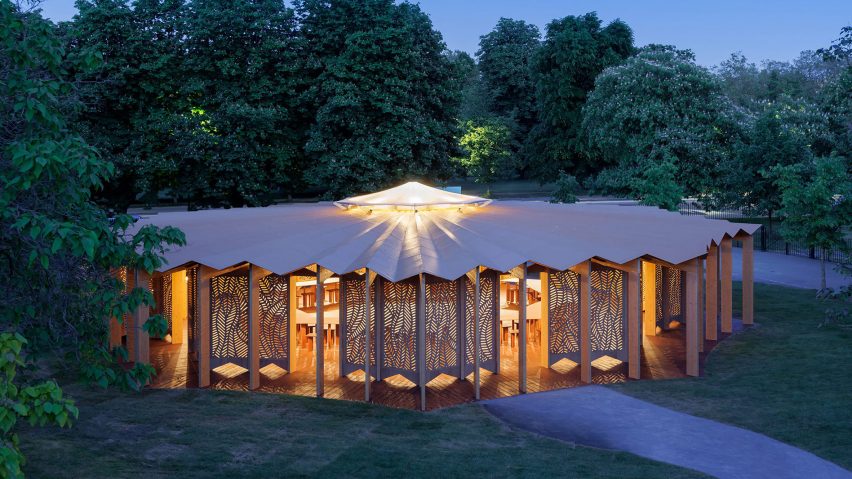Lebanese architect Lina Ghotmeh has created a glulam structure named À Table for the 2023 Serpentine Pavilion in central London, which was informed by table discussions and the surrounding tree canopy.
Ghotmeh designed the 300-square-metre pavilion structure to enclose a trio of scalloped-shaped tables, which were also designed by the architect, creating a gathering space that aims to encourage conversation. The pavilion has a nine-sided shape with scalloped edges that were informed by nearby tree roots.
"À Table is an invitation to dwell together in the same space and around the same table," said Ghotmeh.
"It is an encouragement to enter into a dialogue, to convene and to think about how we could reinstate and re-establish our relationship to nature and to Earth."
"People ask me what makes you feel at home and I always feel at home when I'm eating, which makes me very rooted," Ghotmeh told Dezeen.
"This made me think how rooted we are as climate beings and what brings us all together in this moment when we are really sustainably developing our relationship to one another, but also to Earth," she continued.
"So I started by designing tables, first a large circular table that people can sit around and then from there, I actually started thinking about what a pavilion is."
The pavilion, which will be open to the public on 9 June in London's Kensington Gardens, is topped with a pleated Birch plywood roof. A 3.4-metre oculus in the centre of the roof covered by an EFTE pre-tensioned fabric structure lets in natural light and ventilation.
Slim glued laminated (glulam) timber columns punctuate the pavilion's perimeter, intending to appear like tree trunks. The pairs of columns, which create a gallery colonnade, support cantilevered glulam beams that extend to the centre of the pavilion.
"Everything you can see is structural," said AECOM technical advisor Jon Leach. "Everything is doing a job and serves a purpose."
Wooden screens with leaf-like perforations partially enclose the space while still allowing views out. Triangular cut-outs along the top and bottom mirror the pleated shape of the roof.
"You always have a relationship to the outside, you have this intimacy that you always have a look to the outside and the context and the enrichment of the inside becomes the specificity of the outside," Ghotmeh told Dezeen.
"It's creating porosity with the outside while creating its own intimacy, so it plays with this gradation of relation to the outside – this is something that is very much present in my work."
"Then you have this outer gallery space that is a covered space to shield you from the rain in London," she continued. "And then you have these fretted panels that kind of create a more intimate feel to the interior."
According to Leach, the screens were cut with a CNC machine to ensure precision and minimal waste. Timber waste produced from the pavilion was processed into mulch in a biomass boiler.
The low roof, which measures 4.4 metres high at the centre and drops to 3.1 metres high at the eaves, aims to create a more intimate space where people can gather and sit.
Two main entrances to the pavilion link existing footpaths on the site and a cafe servery provides refreshments for visitors.
The pavilion has a suspended wooden floor placed on a precast concrete pad foundation, which will be removed at the end of the summer. Designed to be demountable, the pavilion will be rebuilt at a different location after it closes at Kensington Gardens on 29 October 2023.
Ghotmeh hopes the 2023 Serpentine Pavilion will provide an intimate, comforting space that visitors can use for reflection.
"I would love people to feel like is a feeling really cocooned in a way, to feel that they are here to use this space to dwell here and at the same time be transported and maybe also have a sense of peacefulness, of slowness and have a sense of ease," said the architect.
À Table is the 22nd Serpentine Pavilion to be built. Last year, Chicago artist Theaster Gates created a black chapel-like structure that aimed to be a reflective space, which followed South African studio Counterspace's 2021 pavilion informed by gathering spaces in London.
The photography is by Iwan Baan.

